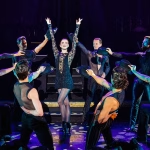Kill The Jockey (2024) — A Jockey’s Fall and the Hallucinatory Traces of Rebirth

Luis Ortega’s Kill the Jockey (El Jockey) weaves a tale of downfall and rebirth, wandering through the dusty racetracks and neon-lit nights of Buenos Aires. The film follows Remo Manfredi, a once-brilliant jockey whose life spirals into collapse. Drug and alcohol addiction, servitude to an exploitative boss, and a fatal race accident push Remo to the brink, both physically and mentally. Awakening from a coma, he escapes the hospital, takes to the streets, sheds his former identity, adopts the name Dolores, dons a fur coat, and embarks on a radically different journey—questioning the boundaries of identity, gender, and belonging.
Nahuel Pérez Biscayart delivers a powerful performance, navigating Remo’s transformation with a delicate balance of fragility and defiance. His physical exhaustion, facial indecision, and bold transition to Dolores make the character’s fractured soul almost tangible to the audience. Alongside him is Abril, a pregnant, successful jockey who has built her own life but cannot abandon her pursuit of Remo after his disappearance. Their bond forms the emotional backbone of the film, constantly tested on the fine line between loyalty and betrayal.
Ortega’s direction elevates the story beyond a conventional sports drama, turning it into a surreal odyssey. Striking race scenes at the hippodrome, a hospital escape, nightclubs, abandoned streets, and unexpected dance sequences transform Buenos Aires into a space both alluring and suffocating. Cinematographer Timo Salminen’s neon-drenched cityscapes translate Remo’s mental disarray into a visual experience. While depicting the vortex of addiction and loss, the film also explores identity and the struggle to redefine oneself, drawing viewers into its hallucinatory atmosphere.
Competing for the Golden Lion at Venice and selected as Argentina’s Oscar entry, Kill the Jockey captivated festival audiences with its bold identity narrative and cinematic flair. Critics lauded Biscayart’s transformation as one of the year’s most unforgettable performances, though the film’s deliberately chaotic structure and heavy symbolism were deemed daring by some and exhausting by others. Most, however, described Ortega’s narrative as a “feverish nightmare seen on horseback,” emphasizing its lasting impact as a boundary-pushing cinematic journey.
Ultimately, Kill the Jockey peers beneath the glossy surface of sports to explore the collapse of fame, the impasse of addiction, and the pangs of rebirth. It challenges societal and personal constructs of masculinity and identity, offering viewers a brutal yet liberating experience. With this film, Ortega not only captures a character’s journey but also brings the mutable spirit of a city and its culture to the screen.



















